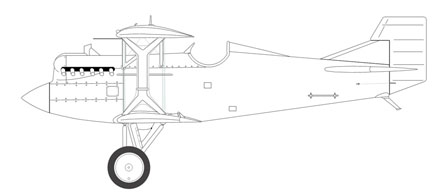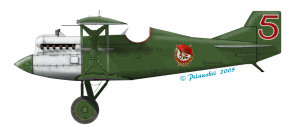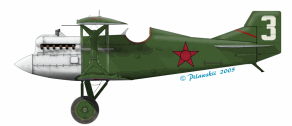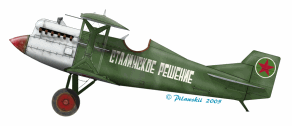Grigorovich I-2bis
By Erik Pilawskii

Grigorovich I-2bisBy Erik Pilawskii |
 |
(Note: You can find a preview of the Prop & Jet 1/72nd vacumformed model of this aircraft in the Modeling section.)
I-2 bis Markings and Camouflage
The I-2 bis fighter was completed at a time prior to the introduction in Soviet factories of the more modern aviation use lacquers (which we recognise today). Sadly, research on this time period is still only in its infancy, but some details are currently known.
Alas, it is a bit silly for the instructions sheet to state that the aircraft was finished in AMT lacquers. These did not exist at the time the aircraft was built, nor for many years thereafter! These are obviously quite impossible as colour options. In fact, the I-2 bis seems to have been finished with a common aviation lacquer in use during the period 1923-30. The properties of this varnish are not currently known, neither is its proper nomenclature. It is referred to in factory documents only as a "protective aerolacquer"; there is no mention of its colouration in these descriptions.
This finish was thought to be a dark-ish green colour, and attempts have been made to compare its appearance to that of known aviation lacquers on photographs showing different examples together. There are also two small surviving examples of this finish, one at the Chkalov Museum, the other on a wing part at Monino. Therefore, the appearance shown in these artworks may be regarded as the most current interpretation of this lacquer. However, it is still only an interpretation, and research on this topic must continue before a more certain value can be entertained.
Moreover, the undersurfaces were by no means finished in blue. This type of colouration was not yet known in VVS service, and the wing and stabilizer unders were merely left in aluminum dope, which was used to cover all of the fabric surfaces during manufacture. The exact colour of the early Soviet aluminum dope is not now confirmed, but it seems likely to have been similar to French products of this type in use during the 20s and 30s, upon which we know it was based.
Usually on the I-2 bis, one sees that the engine panels were left in an unpainted condition. This shows the delightful burnishing marks on the cowl pieces well, and makes for an attractive appearance. Many spinners seem to have been painted with the protective lacquer, but the propellers do not demonstrate any type of painting, and show dark wood colours. The interior was indeed absolutely not "grey" (that horrid old stereotype). Soviet aircraft from this period invariably show unpainted interior pieces. The fabric surfaces were usually covered on the interior side with aluminum dope, but occasionally also in clear lacquer. The instrument panel might have been black, although unpainted examples are known also.
With these basics in mind, let us look at three specific I-2
bis fighters.
| I-2 bis "Red 5" unknown unit assignment Leningrad Military District 1924-26 [Red Stars Vol.3, p. 131] |
 |
This delightful aircraft was finished in typical I-2 bis
fashion in 'protective aerolak', alum dope wing/stab unders, and natural metal
cowl. The number "5" was in red, and was rather an odd font type. A large Red
Banner emblem adorns the fuselage, which also shows no national marking. Plain
red star insignia are visible on the wing undersurfaces, only.
| I-2 bis "White 3"
6 OIAE Kiev Military District 1926 [Krilya Rodinu 5/71] |
 |
A profile of this aircraft appeared in the old issue 5/71 of KR magazine, along with an extremely poor photograph. Indeed, the photo was so bad that most of the profile details could not be made out clearly on it. Therefore, while I think this artwork is correct in detail, it may emerge differently later via a better photograph.
"White 3" looked to have had an unpainted spinner, and a large
tactical number on the rudder (as seems to have been common with the I-2 bis).
The fuselage marking was of the Circle-Star type, and the original drawing shows
these on the wing upper surfaces as well as the lower. The small red stripe
on the fin was indistinct, and based on the magazine artwork.
| I-2 bis "Stalinskoe Reshenie"
NKVD Border Patrol Manchuria 1934 [photo: Obor. Fond Upravlenie 29, 1114/117/81/2] |
 |
This lovely aircraft is depicted in an excellent aerial photograph within the Fond Up.29 collection. The meaning of the inscription has been given in several ways, of which I think that "Stalin's Resolve" is the most likely.
This aircraft must have had a long service life, still in action here in 1934. The star marking on the tail in a green circle denotes the NKVD's border flight aircraft, and to date this is the only I-2 bis I have seen in such markings (the R-5 and Po-2 were most common). The surface is shown with considerable wear, as befitting an aircraft of this age. The spinner and wheels looked to have been red, albeit worn. The inscription appeared to have been newly applied, and was fresh in appearance (as was the star marking). All other aspects of this fighter's appearance look to have been typical.